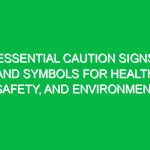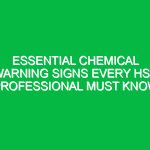Introduction
Good morning, team! Today, we are gathered for our Toolbox Talk to discuss an essential aspect of our daily operations: Verifying Safeguards within the Health, Safety, and Environment (HSE) domain. This topic is crucial for ensuring that we not only comply with Safety Regulations but also create a secure working environment for ourselves and our colleagues. As we go through this talk, I encourage you to engage, ask questions, and share your insights. Together, we can enhance our understanding and practices surrounding Safety in the workplace.
What Are Safeguards?
Before diving into how we can verify safeguards, let’s clarify what we mean by “safeguards.” Safeguards are the measures, procedures, and protocols designed to prevent accidents, injuries, and environmental damage. They can include everything from Personal Protective Equipment (PPE) to safety Training and emergency Procedures. Understanding these safeguards is the first step in implementing them effectively.
The Importance of Verifying Safeguards
Now, why is verifying safeguards so critical in our daily operations? Let’s consider a scenario: Imagine a construction site where workers are required to wear helmets, but some employees decide not to wear them because they find them uncomfortable. If no one verifies that everyone is wearing the necessary PPE, the risk of head injury significantly increases. By regularly verifying safeguards, we ensure that all employees are following safety protocols, which ultimately helps prevent accidents and injuries.
Key Components of Verifying Safeguards
When it comes to verifying safeguards, several key components must be addressed:
- Regular Inspections: Scheduled inspections of equipment, safety gear, and work areas help identify potential Hazards.
- Training and Education: Ongoing training ensures that employees are aware of safety procedures and understand the significance of following them.
- Documentation: Keeping accurate records of safety checks, training sessions, and incident reports allows for better tracking of safety compliance.
- Feedback Mechanisms: Encouraging employees to report unsafe conditions or suggest improvements helps foster a culture of safety.
Best Practices for Verifying Safeguards
To effectively verify our safeguards, we should implement the following Best Practices:
1. Conduct Pre-Shift Safety Checks
Before starting work each day, conduct a quick safety check of tools, equipment, and work areas. This routine can help identify any issues before they lead to accidents. For example, if you notice that a ladder is damaged, report it immediately. This simple act can prevent a potential fall.
2. Engage in Safety Meetings
Utilize Toolbox Talks not just as a formality but as an opportunity to discuss safety openly. Share experiences, lessons learned, and updates on safety protocols. Engaging everyone in these discussions can lead to valuable insights and improvements in our Safety Measures.
3. Implement a Buddy System
Having a buddy system can enhance safety verification. When employees work in pairs, they can help each other remember to follow safety protocols. For instance, if one person forgets to wear their Safety Goggles, their buddy can remind them to do so. This simple check can save lives.
4. Document Everything
Keep a record of inspections, incidents, and training sessions. Documentation is vital for tracking safety compliance and demonstrating that we are adhering to regulations. If an incident occurs, having accurate records can provide essential information for investigations and prevent future occurrences.
5. Review and Update Safeguards Regularly
Safety regulations and Best Practices evolve over time. Regularly review and update our safeguards to ensure they are in line with current Standards and practices. This proactive approach can help us stay ahead of potential Hazards.
Understanding Risks and Hazards
Verifying safeguards also involves understanding the risks and hazards associated with our work. Identifying these risks is essential for creating effective safeguards. Here are some common hazards we might encounter:
- Slips, Trips, and Falls: These are among the most common workplace injuries. Ensuring that walkways are clear and using anti-slip mats can help mitigate these risks.
- Equipment Malfunction: Regularly inspecting tools and machinery can prevent accidents caused by equipment failure.
- Chemical Exposure: Proper labeling, storage, and handling of chemicals are crucial for preventing exposure-related incidents.
Real-Life Examples of Verifying Safeguards
Let’s look at a couple of real-life examples to illustrate the importance of verifying safeguards.
Case Study 1: A Construction Site Incident
On a construction site, a worker suffered a serious injury due to a lack of protective gear. Although the company had a policy requiring PPE, it wasn’t verified regularly. After the incident, management implemented a new verification process where supervisors would conduct daily checks to ensure all workers wore their PPE. This change led to a significant decrease in injuries on the site.
Case Study 2: Chemical Spill Prevention
In a manufacturing facility, employees were not consistently following the proper procedures for handling chemicals. After an incident where a spill occurred, management decided to review their safeguards. They introduced a system of checks to ensure that all employees were trained in chemical handling and that protective equipment was available and used. This proactive approach greatly reduced the risk of future spills.
Regulations and Compliance
Understanding the regulations and standards related to verifying safeguards is crucial. Compliance with OSHA (Occupational Safety and Health Administration) regulations, for instance, is not just about avoiding penalties; it’s about ensuring a safe work environment. Regularly reviewing these regulations helps us stay compliant and protects our employees.
Encouraging Open Dialogue
As we conclude today’s Toolbox Talk, I want to emphasize the importance of open dialogue regarding safety. I encourage you all to share your thoughts and experiences related to verifying safeguards. What challenges have you faced, and how have you overcome them? Remember, your insights can lead to meaningful changes that enhance our safety practices.
Conclusion
In summary, verifying safeguards is a critical part of our daily operations in the HSE domain. By conducting regular inspections, engaging in safety discussions, documenting our practices, and understanding the risks involved, we can create a safer working environment for everyone. Thank you for your commitment to safety and for participating in today’s Toolbox Talk. Let’s continue to work together to ensure that our workplace remains safe and secure.


